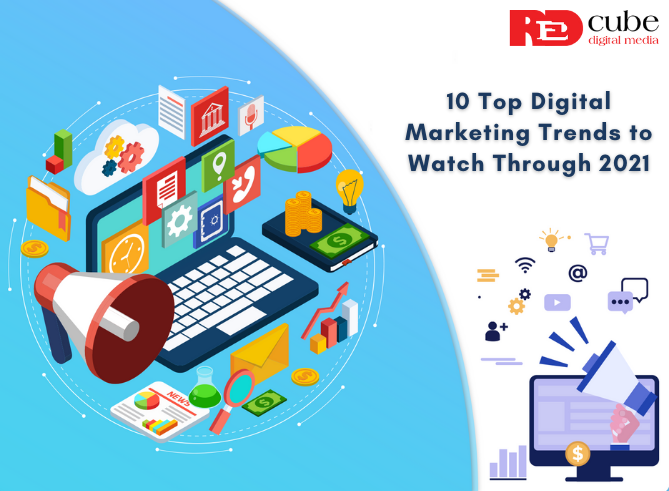As the worldwide pandemic accelerated the pace of change over the years, digital transformation became a reality for all organizations this past year. Future trends that you used to guide your digital marketing strategy may no longer be relevant, while new concerns have arisen to demand our attention. Consumer demands and preferences have shifted tremendously.
Let’s take a look at what’s popular right now to see where you should focus your spending in the coming quarters to stay ahead of the pack.
1. Consumer Behavior Changes in the Digital Age Are Here to Stay
The time has passed to pivot and meet the need for quick and easy online purchasing, curbside pickup, and contactless delivery. Companies are now focusing on securing and resiliency in the future. According to IBM’s latest Institute for Business Value survey, 52 percent of retail organizations prioritize shifting to more resilient infrastructure, along with integrating contactless mobile payments (47 percent) and building more robust digital selling platforms (45 percent).
According to my company’s research, there’s no use in waiting for things to get back to normal, as a vaccine and re-opening are already producing new online search opportunities. Before the pandemic, any plans you had in place (or shelved as poor priority) must be re-evaluated and re-prioritized. Put everything on the table: deadlines, budget, scope, and priority order. Some initiatives may need to be hastened, while others may need to be abandoned outright.
Plan for where you want to be five years after COVID, not where you imagined the company would be by now if it hadn’t happened.
2. Marketers must use real-time data to stay ahead of consumer demand
You’re missing out on a huge chance to connect and engage if your company isn’t set up to listen to, analyze, and then act on these insights with real-time customization. Consumers are openly notifying brands about their wants, requirements, and intent in search queries and onsite behavior. Put the people, processes, and technology in place to make the most of this essential consumer data.
3. Improving Content Quality and Velocity to Gain an Advantage
Compared to your more productive competition, if you put a lot of effort and thought into your content but can only post once a month, you’re missing out on many opportunities to appear in search, social, email, and other channels.
Nonetheless, we understand the value of expertise, authority, and trust (E-A-T) in the material. It’s pointless to produce a large volume of low-quality information. Instead, consider what you need to improve and put in place to produce high-quality content on a large scale.
4. Customers want brands to provide them with connected digital experiences
According to Salesforce’s recent State of the Connected Customer survey, 80 percent of customers believe that a company’s experience is just as necessary as its products and services. Customers want agents to access their information, whether they’re chatting with an AI support bot, calling a customer service representative, or interacting with sales.
They anticipate that one interaction will continue where the last one ended and that they will not have to start over with each new interaction with the brand.
Manufacturing, construction, and agriculture, for example, have been slow to adopt digital transformation. They are now being challenged to keep up with retail, business services, and other fast movers.
5. Intelligent Digital Automation Goes Beyond Simple Replication
The number of consumer contacts and touch-points has exploded, which is a crucial digital trend. The amount of data we need to assess has skyrocketed. Deep learning, machine learning, natural language processing, and robotic process automation (RPA) are all making inroads into SEO and digital marketing workflows as a result.
Intelligent automation entails removing the need to make every decision. It involves giving machines the ability to behave in pre-programmed if/then scenarios and learn about and get to know each client in ways that humans simply cannot. It also entails allowing those computers to operate in real-time when the customer is most receptive to personalized messaging, content, deals, and recommendations.
6. The Importance and Value of First-Party Data is Growing
The value and usefulness of first-party data are evident as ad targeting and behavioral analysis become more challenging. Prepare now for queries and concerns from customers about privacy, data storage, and disposal. Determine the value you can provide consumers in exchange for their personal information. Examine the implications of this development for your measurement and analytics operations.
7. Hyper localization Extends Beyond Geographical Boundaries
The epidemic brought heightened awareness of supply chain difficulties and a widespread desire among customers to support small businesses. While “value for money” was the top purchase motivator for customers questioned by KPMG in late 2020, Ernst & Young recently discovered that 69 percent of consumers feel brands must positively impact the planet. This is especially essential for Millennials, who consider it essential that the businesses they buy from have values similar to their own.
In addition to geo-targeted material – providing information about local landmarks on your GMB profile, developing unique blog content by region, and hyperlocal ad targeting – acquiring hyperlocal means understanding what truly matters to customers in any given location.
8. PPC and SEO Strengthen the Relationship
Paid and organic search will be genuine partners in crime in the future; one should startup where the other left off. Both teams should be aware of the available SERP features and placements on the most valuable brands in the company. They must collaborate to provide the most consistent coverage on those parameters while keeping expenses to a minimum to maximize ROI.
For example, SEO data is now providing product teams with greater insight into client preferences. As Google prepares to roll out the Page Experience Update, our new research demonstrates that some businesses are better prepared than others for Core Web Vitals. This means that technical SEO will be a requirement, not an option, for organizations that need to train more than others. Beyond communicating data and results back and forth, SEO and PPC synergy is required.
In today’s marketplace, proactive preparation and a shared commitment to giving the greatest possible answer to each consumer’s requirement at every stage of their buying experience are required.
9. Greater Relevance through Semantics, Entities, and the Knowledge Graph
It’s critical for marketers and SEO professionals to keep up as Google’s Knowledge Graph improves its grasp of searcher intent. This is what SEO is all about; we can’t optimize content without at least a basic comprehension of Google’s requirements.
10. Our Working Practices Have Changed
COVID-19 forced employees to leave the office in droves, and there was no hurry to get back to business as usual.
And, despite widespread fears that we weren’t ready for entirely remote work and that it would be disastrous for businesses, 70% of managers indicated that productivity remained consistent or even improved.
The way we cooperate and innovate is changing, and in many firms, the shift to remote work has hastened the flattening of organizational structure. We were obliged to innovate and problem-solve swiftly as a result of the outbreak. It propelled us over the technological and human constraints that had slowed the acceptance of remote work.
According to McKinsey, marketing and other professional services are among the industries with the most potential for successful remote work in the future. In addition to the technical components of the work, SEO and digital marketing team leaders must schedule time for remote people management.
How to Take Advantage of These Digital Marketing Trends
Trends in digital marketing and SEO indicate how something is evolving, changing, or moving in general. They aren’t a road map; there isn’t a one-size-fits-all answer to the issues listed above. Keep an eye on them, though. Examine the influence on your marketing department and the company as a whole.
If the past year has taught us anything, we need to be flexible when it comes to people, technology, and digital trends, as well as be ready to respond to whatever market conditions arise next.



